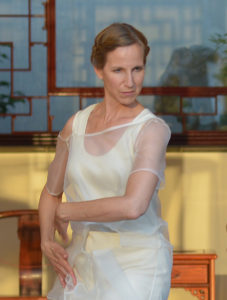Redefining Contemporary and Traditional Dance: Views from Canada, Peru and India - Vancouver Ballet Society
- Home
- Features 2020 - 2023
- Redefining Contemporary and Traditional Dance: Views from Canada, Peru and India

By Rachel Silver Maddock
Two years ago, seven Vancouver dance artists from very different aesthetic backgrounds came together to thrash out and define the meaning of contemporary and traditional in terms of their dance practice. Colleen Lanki of TomoeArts, who works in the Japanese form of nihon buyoh; Margaret Grenier of Dancers of Damelahamid, who works with Indigenous dance; Lesley Telford of Inverso Productions, who comes from a contemporary ballet background; and others working in flamenco and Bharatanatyam, all agreed that the word classical or traditional just doesn’t cut it when describing their work.

As artists who create contemporary performance using traditional forms, they asked questions around how their work is received and programmed, and discussed inequities in access to funding, training and performance opportunities. How can you describe dance that doesn’t fall into the big C category of mainstream Contemporary without getting pigeon-holed into either a traditional or classical category?
Lanki found the conversation so rich she initiated an online symposium in 2020, Redefining the Contemporary. Three country-specific discussions held over Zoom and Facebook Live expanded the topic in fascinating ways in Canada, Peru and India. At each event, dancers spoke about their work, shared short performance clips and participated in Q&As with the public.
Since then, the videos of the Peruvian and Indian events have had over two thousand views, and a written synopsis of the Canadian discussion is posted online.
One benefit of the pandemic and the move to virtual platforms is the proliferation of international conversations around pertinent topics like this one. Though thousands of miles apart, many of the panellists brought up similar issues. During the Canadian discussion, as Lanki, Grenier, Telford and Sujit Vajda (an independent Bharatanatyam dancer) opened up their practices to provide fodder for the discussion, questions arose around the hereditary lineages of dance and the difference, in the public eye, between appreciation and appropriation of dance style and form.
For Lanki — who practices, performs and teaches nihon buyoh as a white woman in Canada — her presence in the form has caused controversy, despite many years of intensive training in Japan. In her presentation, she asked: What happens when dance forms cross the boundaries of race, culture and geography? Who has the right to practice a cultural form and to teach it, and why couldn’t nihon buyoh be regarded as international as ballet, which is performed and appreciated around the world?

Pamela Santana (co-organizer of the symposium) explained in an interview on Zoom that many of the Peruvian panellists at the Spanish-language event work in ways that intentionally transform or bend Peruvian dance through costume, music or gender roles. As a result, they experience challenges when applying to present their work: they are generally perceived as too traditional for contemporary dance festivals and too contemporary for traditional ones.
Santana said that dance forms in Peru often reflect the social exclusions within that country’s culture. This issue was echoed in the Indian panel a week later by Hanne M. de Bruin, who works in kattaikkuttu theatre in Tamil Nadu. De Bruin explained that “folk” performance in India is viewed as lower than other forms — as less rigorous than those classified as classical, like kathak and Odissi dance. As a result, practitioners of kattaikkuttu have little to no financial resources to draw from.
Across the board, as the panellists dove into the history of their forms, it quickly became clear that so-called traditional or classical dance styles are in reality always changing and adapting — influenced by politics, technology and popular culture. Everything from belly dancing to ballet evolves through the generations by those who practice and teach. Santana encapsulated this idea beautifully by saying, “Tradition is memory, and memory adapts and transforms because it is present in an actual body.”
The topic becomes even more significant as dance performance is increasingly adapted for the digital realm, where artists working in classical forms are finding new and innovative ways to share their ideas. Divya Ravi, a performer of Bharatanatyam, creates short videos for Instagram around social issues, including one on veganism.
In her symposium presentation, Ravi suggested that instead of seeing classical and contemporary dance on opposite sides of the spectrum, perhaps contemporary could be seen simply as art created in the present as a response to current situations. After all, contemporary expression is what makes all dance forms — whether the steps are old or new — alive and relevant.

